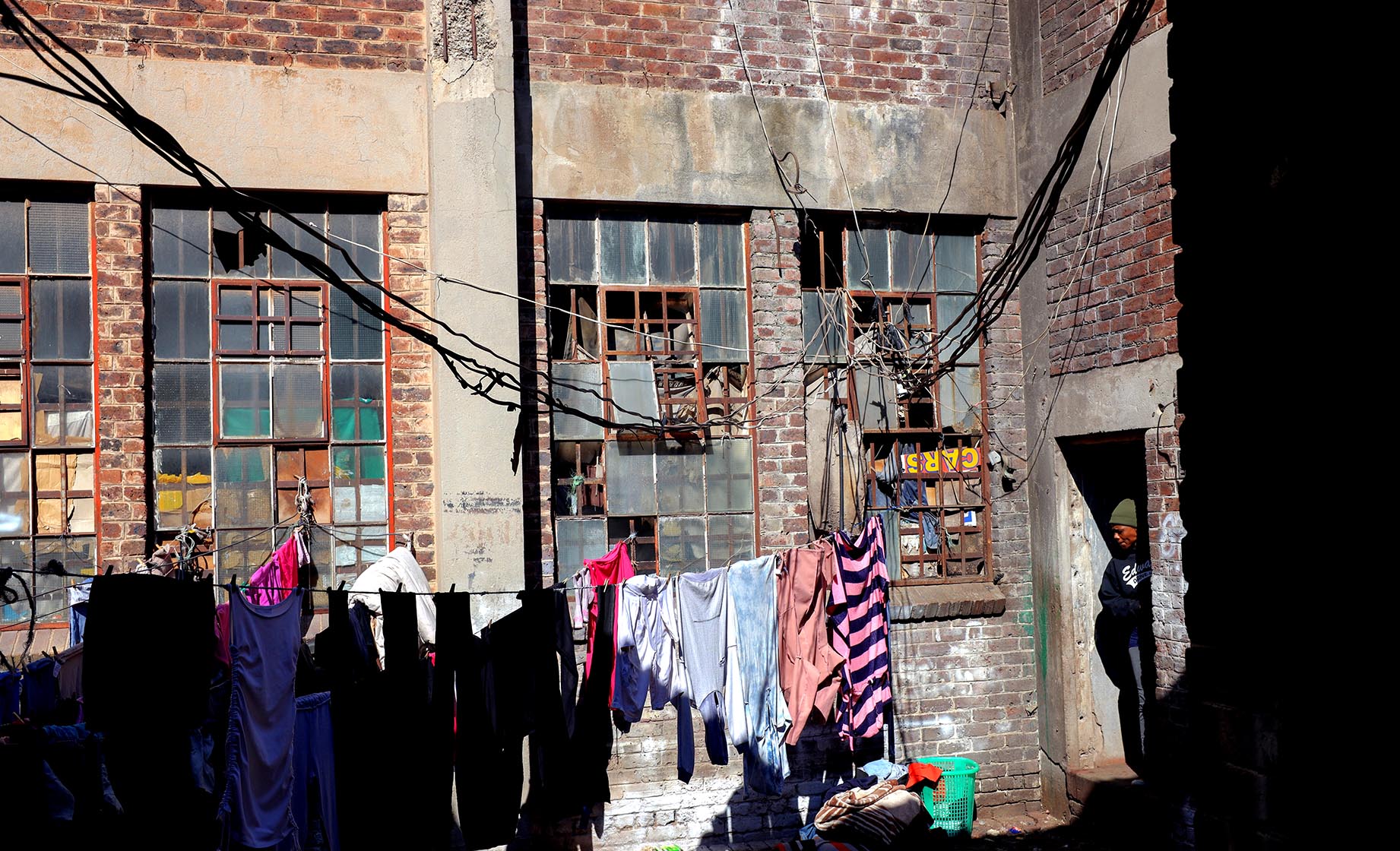The long-anticipated hearing of the second phase of the Khampepe Inquiry resumed last week, aiming to tackle Johannesburg’s building hijacking crisis. Initially convened to uncover the causes of the August 2023 blaze that killed 76 people, the inquiry has since expanded to address the conditions of hijacked buildings across Johannesburg and Gauteng province. This shift follows a comprehensive inspection conducted over September of 140 buildings suspected of being hijacked.
The initial first phase of the Khampepe inquiry into the Usindiso fire found the City of Johannesburg and its entities liable for the 76 deaths, however almost six months later the City has not responded to the inquiry.
Decay and despair in the city
The inquiry’s findings paint a concerning picture, revealing that most inspected buildings are in poor condition and often uninhabitable, with severe issues such as overcrowding, lack of basic services like water and electricity, unsafe structural conditions, and a lack of fire equipment.
One notable case is the historic old Post Office on 1A Rissik Street. Now housing 14 families and approximately 42 residents, the City-owned heritage building has been converted into a residential site. During inspections, the commission discovered appalling living conditions: cardboard partitions between rooms, communal facilities, no bathrooms or showers, no fire safety equipment, and only a single outside water tap.
 Inside the building in Doornfontein during the commission's inspection on 3 July 2024 in Johannesburg, South Africa. (Photo: Gallo Images / Lubabalo Lesolle)
Inside the building in Doornfontein during the commission's inspection on 3 July 2024 in Johannesburg, South Africa. (Photo: Gallo Images / Lubabalo Lesolle)
Advocate Ishmael Semenya, leading the commission’s evidence, reported: “The building’s interior structure is dilapidated… it is prima facie unsuitable for human habitation as it poses both fire and structural collapse risks.”
Although a court order mandates the residents’ relocation, the City has yet to provide the promised temporary emergency accommodation. However, the Commission heard that the City of Johannesburg currently does not have such accommodation that could house any person in distress.
Read more: City of Joburg’s bid to provide emergency accommodation highlights housing crisis
Similar conditions were noted at Industry House on 5 Davies Street, where approximately 650 people live in overcrowded and unsafe conditions.
A bleak snapshot of the Moth building
Among Johannesburg’s storied buildings is the Moth building on De Villiers Street, whose dilapidation mirrors a city struggling with infrastructure decay. Once a symbol of modern urban living, the building now suffers from severe neglect. Inspections revealed exposed sewerage, ceiling boards used as makeshift partitions, broken windows, faulty electrical connections, and missing fire equipment. While the building does not fall under the category of hijacking, it remains overcrowded and in disrepair. The very same building is used as temporary emergency accommodation by the City of Johannesburg.
Read more: Joburg’s forgotten people: Inside the Moth building
Semenya said that about 7% of its occupants were unofficial residents, reportedly brought in by others with valid accommodation agreements. According to a report by the City’s Group Forensic Investigation Services, this property was allocated as a temporary shelter for three groups of occupiers relocated from other buildings. The Group Forensic Investigation Services also estimated that R5.3-million would be required to refurbish the Moth building’s deteriorating condition — a two-year process that would necessitate relocating residents in the meantime.
Pockets of hope amid urban decay
Not all buildings inspected by the commission were in similarly poor condition. Some, while not flawless, retain a sense of livability and community.
Ponte City Tower, a prominent residential skyscraper in Johannesburg’s Berea district, once symbolised both urban aspiration and decay. Built in 1975, Ponte held the title of Africa’s tallest residential building for nearly five decades. Yet, as the years wore on, the building gained notoriety as a hub for crime and mismanagement. Allegedly abandoned by its owners, Ponte fell into disrepair, reflecting the downward trajectory of the surrounding neighborhood. But recent inspection findings show that despite its past, Ponte is structurally sound and fit for habitation, offering a glimmer of optimism for the future of Johannesburg’s highrises.
https://www.youtube.com/watch?v=3EIKmmSifqw
The duality of Astor Mansions
Astor Mansions, one of Johannesburg’s oldest highrises, exemplifies the city’s architectural heritage. This Art Deco treasure, located at Von Brandis and Rahima Moosa streets, has long been compared to Miami’s vibrant architectural landscape. Unlike many buildings inspected by the commission, Astor Mansions’ exterior remains pristine. However, conditions inside are less inspiring: waste disposal near fire escapes, leaking water, and poorly maintained restrooms.
Despite these interior issues, the privately owned 10-storey building, home to about 100 residents paying monthly rents of R1,900 to R3,500, was deemed structurally sound. The commission acknowledged minor cosmetic flaws while also noting several City bylaw non-compliances.
The Khampepe Inquiry, led by retired Justice Sisi Khampepe, will continue its work until December 5, 2024. DM




 Inside the building in Doornfontein during the commission's inspection on 3 July 2024 in Johannesburg, South Africa. (Photo: Gallo Images / Lubabalo Lesolle)
Inside the building in Doornfontein during the commission's inspection on 3 July 2024 in Johannesburg, South Africa. (Photo: Gallo Images / Lubabalo Lesolle) 